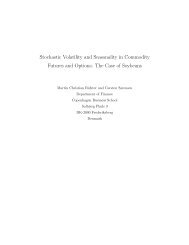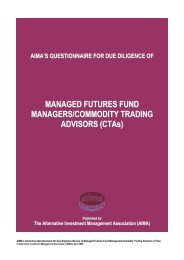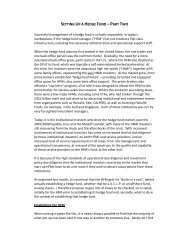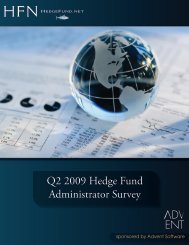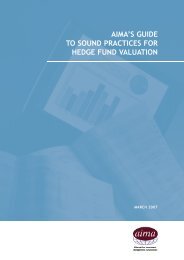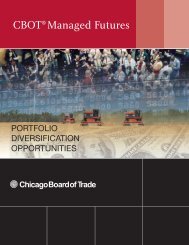Lintner Revisited: A Quantitative Analysis of Managed ... - CME Group
Lintner Revisited: A Quantitative Analysis of Managed ... - CME Group
Lintner Revisited: A Quantitative Analysis of Managed ... - CME Group
Create successful ePaper yourself
Turn your PDF publications into a flip-book with our unique Google optimized e-Paper software.
cmegroup.com<br />
MANAGED FUTURES – SOME BASIC PROPERTIES<br />
A discussion <strong>of</strong> managed futures performance, particularly during<br />
periods <strong>of</strong> market dislocation, may be more illuminating if preceded<br />
by a brief discussion <strong>of</strong> what managed futures are and are not. As<br />
previously mentioned, managed futures encompass a variety <strong>of</strong><br />
active trading strategies which specialize in liquid, transparent,<br />
exchange-traded futures, options, and foreign exchange, and may<br />
be thought <strong>of</strong> as a liquid, transparent hedge fund strategy. Like<br />
long/short equity and equity market neutral hedge fund strategies,<br />
managed futures strategies may take long and short positions in<br />
the markets they trade, are available only to qualified investors,<br />
and may employ leverage. An important difference, however,<br />
is that equity hedge fund leverage requires borrowing funds at<br />
a rate above LIBOR, whereas managed futures investing allows<br />
for the efficient use <strong>of</strong> cash made possible by the low margin<br />
requirements <strong>of</strong> futures contracts. Rather than allowing cash not<br />
being used for margin to collect interest at the investor’s futures<br />
commission merchant (FCM), the investor can deploy it to gain a<br />
higher notional exposure when investing using a managed account.<br />
Consequently, the investor is not paying interest, since they did<br />
not need to borrow money to get the extra exposure. The following<br />
example helps to highlight this important point.<br />
Example: A pension plan sponsor has $50 million (USD), and<br />
wishes to get $50 million exposure in a managed futures strategy<br />
that allows for a funding factor <strong>of</strong> two. The investor then only needs<br />
to invest $25 million to the managed futures strategy and may put<br />
the other $25 million in Treasury bills to receive interest.<br />
Another critical difference between futures and equities is that<br />
there are no barriers to short selling in futures. Since two parties<br />
agree to enter into a contract, there is no need to borrow shares, pay<br />
dividends, or incur other costs associated with entering into equity<br />
short sales. Thus, in that sense, it is easier to invoke a long-short<br />
strategy via futures than it is using equities.<br />
<strong>Managed</strong> futures traders are commonly referred to as “Commodity<br />
Trading Advisors” or “CTAs,” a designation which refers to a<br />
manager’s registration status with the Commodity Futures Trading<br />
Commission and National Futures Association. CTAs may trade<br />
financial and foreign exchange futures, so the Commodity Trading<br />
Advisor registration is somewhat <strong>of</strong> a misnomer since CTAs are<br />
not restricted to trading only commodity futures. The highly<br />
diversified and global nature <strong>of</strong> the markets included in most<br />
managed futures programs makes the selection <strong>of</strong> a passive longonly<br />
index for analysis <strong>of</strong> value added through active management<br />
extremely difficult since many CTAs trade portfolios <strong>of</strong> futures<br />
contracts which span across all asset classes. The name Commodity<br />
Trading Advisor also results in the common mistake <strong>of</strong> using<br />
passive long-only commodity indices, such as the Goldman Sachs<br />
Commodity Index (GSCI), DJ AIG Commodity Index (DJ AIG),<br />
and Rogers International Commodity Index (RICI) as performance<br />
benchmarks. These indices are not appropriate because they include<br />
only a small fraction <strong>of</strong> the futures markets most CTAs trade,<br />
and do not account for active management or the ability to take<br />
short as well as long positions, all <strong>of</strong> which should result in lack <strong>of</strong><br />
correlation over time.<br />
Active management and the ability to take long and short positions<br />
are key features that differentiate managed futures strategies<br />
not only from passive long-only commodity indices, but from<br />
traditional investments as well. Although most CTAs trade equity<br />
index, fixed income, and foreign exchange futures, their returns<br />
should be uncorrelated and unrelated to the returns <strong>of</strong> these asset<br />
classes because most managers are not simply taking on systematic<br />
exposure to an asset class, or beta, but are attempting to add alpha<br />
through active management and the freedom to enter short or<br />
spread positions, which can result in totally different return pr<strong>of</strong>iles<br />
than the long-only passive indices.<br />
4<br />
Past performance is not necessarily indicative <strong>of</strong> future results.


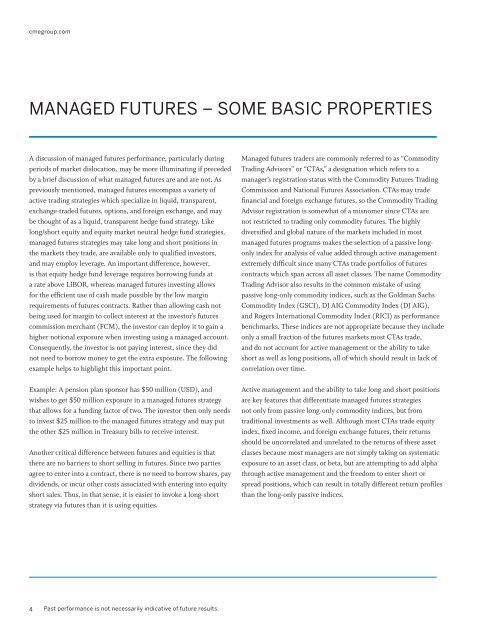
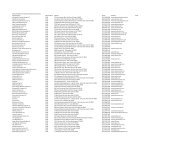
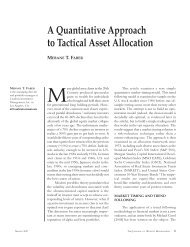
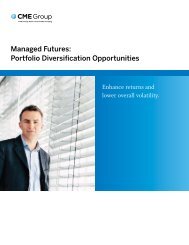
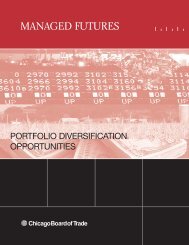
![Definitions & Concepts... [PDF] - Cycles Research Institute](https://img.yumpu.com/26387731/1/190x245/definitions-concepts-pdf-cycles-research-institute.jpg?quality=85)
